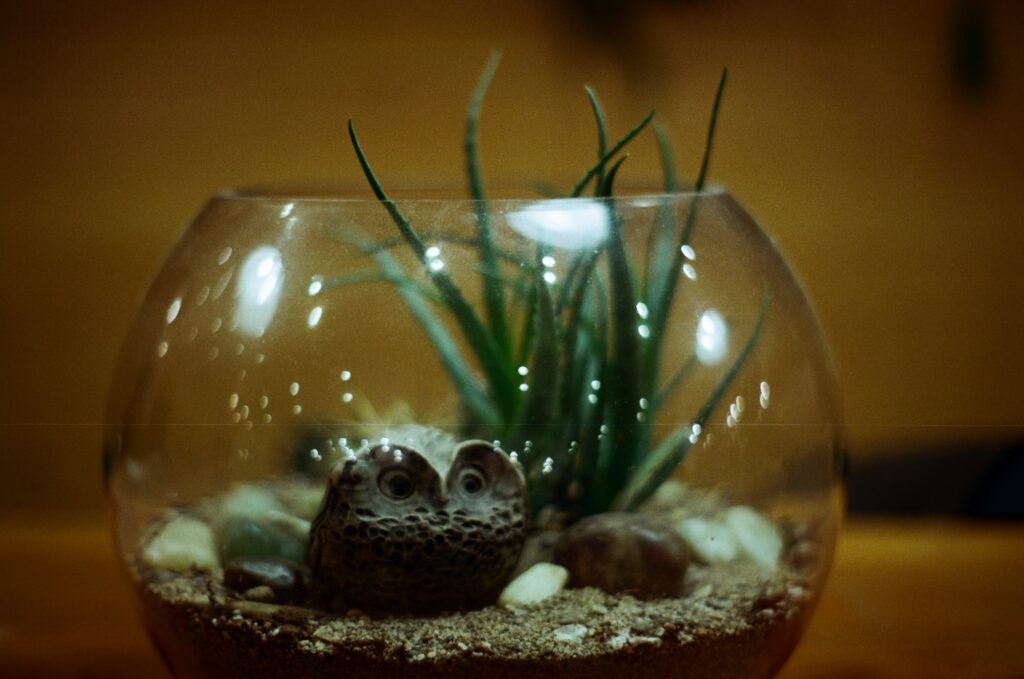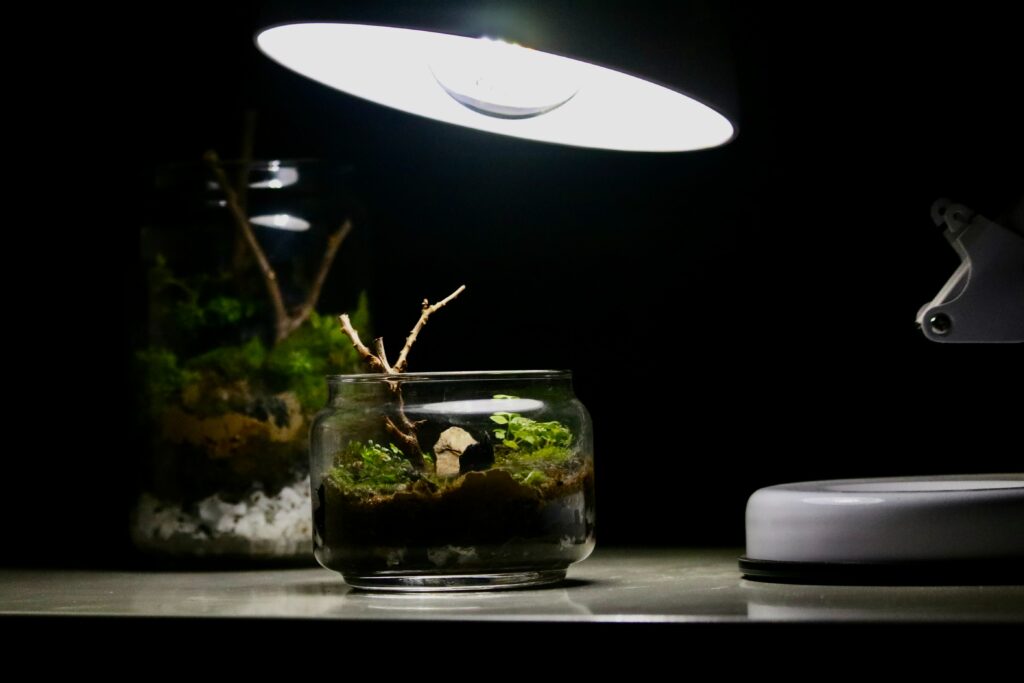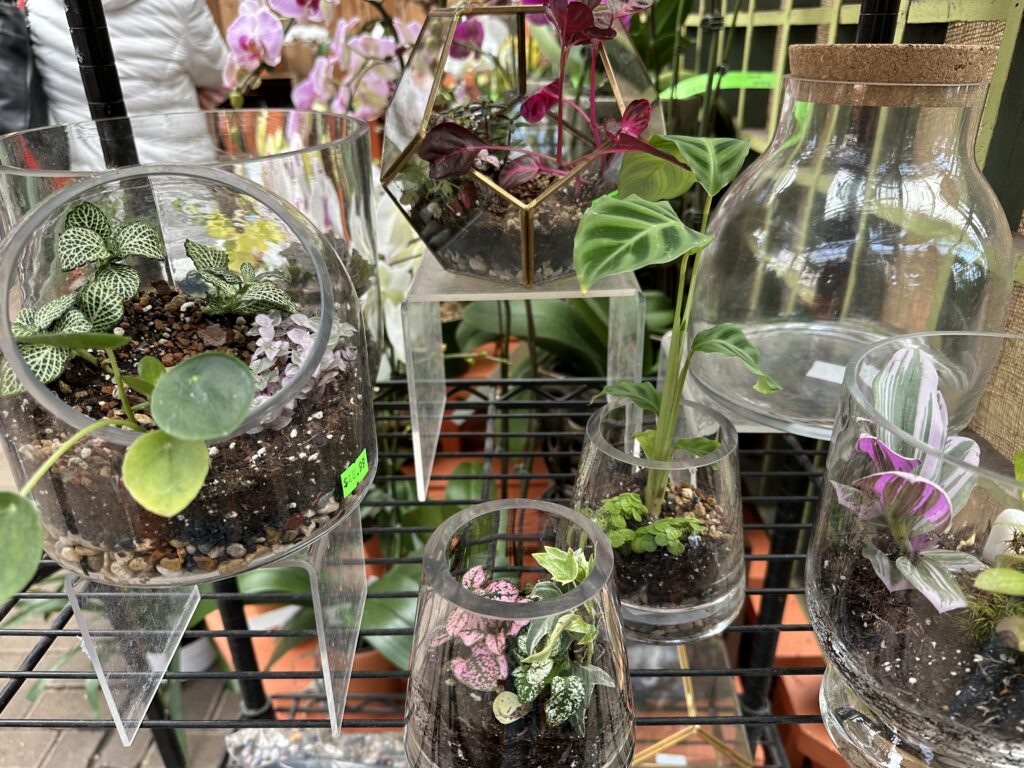Terrariums are one of the most beautiful ways to grow and display plants. Striking glass enclosures bring a feeling of nature into our homes, and can range in design from miniature Victorian greenhouses, groovy 1970’s biomes or the contemporary blown glass containers of today. With their stunning looks come a new set of care requirements, and some people find terrariums way more challenging to maintain than regular potted plants. In this guide, we’ll share our best terrarium tips for your terrarium we learned from our 10+ years of caring for terrariums.
Contents
Picking the Best Terrarium Containers

1. Glass or durable plastic containers can work great for terrariums. It’s easier to choose a container with a wide opening that makes it easy to get your hands inside and work within.
2. Think outside the box. Fish bowls, mason jars, vases or even wine decanters can make great terrariums – even if their intended use was for something very different.
3. Don’t limit your container selection to jars, glasses, or other containers that can completely seal off. As we’ll discuss in the “Air” section, terrariums need open air to provide proper plant health.
4. Checking your local thrift store for interesting containers can help save significant terrarium money, and make this an easier investment if you’re looking to build your first terrarium.
5. Soda or alcohol bottles that have taper off towards the top opening may look interesting, but these containers are difficult to work with and will also constrain your plants as they grow.
6. Similarly, avoid tinted glass with containers like candle hurricane vessels to ensure your plants can get enough light to grow and stay healthy.
7. If you’re choosing glass, be sure the container is thick enough to work within. Containers like wine glasses or anything with a similar thickness may shatter easily, ruining your terrarium and potentially cause injury.
8. While your container doesn’t have to be water tight, this makes ongoing care much easier. If you’re choosing something with gaps or holes near the bottom, you can glue these closed or place the terrarium in a saucer to ensure waterings don’t make a mess.
9. Start small – especially for your first terrarium. It may be tempting to choose a very large glass container for your first terrarium, but smaller glasses – like mason jars – can help teach you the feel for ongoing maintenance more easily before expending your collection.
10. Containers with a broad, wide base help fit more plants while making them less likely to topple over if kept on a regularly used surface like a coffee table.
Choosing the Best Terrarium Plants

11. The “sealed off” nature of terrariums add to their allure, but also make them more challenging to grow plants inside. Succulents or cacti will be easier to grow, due to their hardiness and more forgiving nature.
12. Tropical plants can still be grown in terrariums, but need more work to make sure you don’t overwater them which can attract pests. These plants will also require more frequent pruning due to their faster growth compared to succulents.
13. Cacti and succulents are also great terrarium plants because they prefer to be crowded together and have smaller roots, so the soil level can kept lower, giving you more real estate for plants and decor.
14. Don’t mix and match plants with different care needs in a terrarium. Cacti and tropicals need very different needs, and catering to one kind of plant will likely mean the other will decline very quickly.
When choosing plants, plan for future growth. If your terrarium feels crowded today with your plants, it will likely look overgrown and messy in a few months.
15. Pick plants with different textures, shapes and leaf patterns to create visual interest. In my terrarium, I have small Barrel cacti, a tall Elephant Plant succulent and a compact Fairy Castle cactus.
16. When it’s time tp plant up your container, use the largest plant first, and then work others in by decreasing size. Doing so will prioritize space and make sure everything fits.
17. The best tools to help guide plants and handle cacti into terrariums are chopsticks. Use them to dig small holes for your plants, guide them in, and then anchor them with soil.
18. One of the best terrarium tips is to use chopsticks to remove dead leaves and debris as part of ongoing plant maintenance.
19. It’s ok to swap or replace plants if they grow too large for your terrarium. Succulents are easiest to cut back and form cuttings if they get too large so your terrarium always looks perfectly manicured.
20. Remove brown leaves and dying plants immediately. Look for signs of pests or root rot. The contained nature of terrariums makes plants prone to decline, so pay careful attention to what your plants are telling you.
Which Terrarium Soil to Use

21. The level of soil is the most important aspect of terrarium design. Tropical plants should have a gravel or substrate layer to help filter water, and at least 1-2” of well-draining soil (succulent mix is great here) to promote healthy growth.
22. Succulents and cacti have easier needs. They require less soil than tropical plants due to their smaller root systems which makes them an attractive choice for new terrarium enthusiasts.
23. Soil doesn’t have to be perfectly level inside the terrarium. For larger containers, small hills can add visual interest for your plants.
24. Choose well draining soil like a succulent mix, even if you have tropical plants. This will allow water to pass through to the substrate level helping avoid your plants from sitting in standing water.
25. If dirt gets on the sides of your terrarium, use a spray bottle to wash it back to the surface, keeping your glass clean.
26. If you want to ensure your water is extra filtered, you can add a layer of activated carbon on top of your bottom gravel, and add your soil on top. When the water rises from the gravel, it will pass through this before reaching the soil, helping filter out any impurities.
27. Avoid getting waterlogged soil so your plants do not develop root rot or attract pests. If soil stays soaked for over a day, it may kill your plants – especially if you have a cacti terrarium with plants used to dry, desert conditions.
28. If you notice small gnats or other pets, it’s a telltale sign that you may have overwatered your terrarium, or nearby plants may be infested.
29. A small sprayer with equal parts apple cider vinegar and water should neutralize fruit flies or gnats if you notice a handful.
30. If you notice more widespread issues, it may be best to replant your terrarium with fresh soil to avoid killing your plants.
Personalized Terrarium Decor

31. Small decor pieces can add an element of fun and personalization. Plastic or metal items work best to avoid rot. Wood toys or items aren’t recommended for this same reason.
32. Rocks, minerals and fossils can also enhance the landscape appearance of your terrarium. Place these after your plants to ensure they’re visible and not hidden behind foliage.
33. Stones can also work with soil layers to create hills and valleys to add more visual interest and different layers to plant across in your terrarium.
34. For styling, don’t add more than a handful of items. Your main attraction should be your plants!
If decor items shift or fall while planting, moving or watering, use the same chopsticks to position your plants to work with your decor pieces.
35. River stones or gravel can add a naturalistic look to your terrarium for those looking for a forest-themed container.
36. Similarly, a layer of sand matched with rocks can add a desert feel to a succulent and cactus terrarium. As plants grow, it’s ok to redecorate and move objects around to accommodate the changing terrarium look.
37. Like containers, thrift stores or inexpensive toys can add fun decor if you’re looking to get beyond a naturalistic terrarium vibe.
38. While many people think dyed moss works well for terrariums, it’s more prone to causing rot and should be avoided.
39. Life moss can work in tropical terrariums but the challenge to keep the moss alive and well may not be worth the cost, especially for beginners.
Terrarium Tips for Design and Layout

40. Terrariums should feel thoughtfully designed. Smaller containers can beautifully house one plant and a few decor items, while larger containers can be home to a handful of smaller plants of different shapes and sizes.
41. Make every corner of your terrarium have a point of visual interest. You can achieve this with different plants, hills designed with different soil/rock levels, or decor items like crystal or figurines.
42. A variety of plant sizes will create a layered effect in your terrarium that will attract the attention of your guests.
43. Beyond size, use color, texture, and shape to create moments throughout your terrarium.
44. Rocks, minerals or crystals can add dramatic color to your terrarium and elevate their appeal as decor items.
45. Think of how your terrarium fits into the bigger picture of your room. If your living room is light and airy, maybe opt for lighter sand. If it’s dark and moody, black sand or rocks can help it naturally fit within your design aesthetic.
46. Plan for change. While things may look perfect today, know that your terrarium is a living object and will growth with time.
47. It’s ok to move items. If you find cool decor after you plant up your terrarium, use your chopsticks to do some light redecorating.
48. Make it yours! Outside of basic care, there really aren’t many rules for terrarium decor and design. Have fun and show off your plants!
49. Showcase an eclectic collection. Some terrarium designers focus their designs on their crystal or mineral collections, opting to have 1-2 simple air plants instead of a fully planted container. This is completely fine and for some people, even preferred!
Watering Your Terrarium

50. It is incredibly easy to add water to your terrarium. It’s next to impossible to remove water from terrariums. Water very carefully!
51. Since there is no drainage in your terrarium, excess water has no choice but to pool at the bottom. If you accidentally overwater, absorb excess moisture with dish towels and place your container in a warm spot to promote evaporation.
52. Too much water can cause your soil to become waterlogged, keeping plant roots wet and opening them up for root rot which will eventually kill your plants.
53. Use a spray bottle to water down the inside sides of the terrarium to keep the glass clean.
54. Don’t worry as much about watering each individual plant. Instead, give the terrarium a good watering and watch as water cycles through the soil and gets evenly distributed across the container.
55. The glass sides make it much easier to see the water level vs. traditional potted plants. Always make sure the water level is below the roots, and only water when most of the soil is dry – even for tropical plants.
56. Terrariums do not require special water. If your regular houseplants are happy with your tap water, this will also be fine for your terrarium.
57. Depending on the shape of your container, watering cans may not work well. Using a spray bottle with an untwisted cap or a glass may be easier to handle.
58. The mostly closed-in nature of terrariums mean you may have to water them less often – this is especially true for cactus and succulent terrariums. Look at your soil and plants to see if they seem in need of water vs. keeping to a fixed schedule.
59. If we couldn’t emphasize it enough, always lean on the side of less water, not more – over time, you’ll develop a natural handle for your terrarium’s water needs.
Perfect Terrarium Lighting

60. The lighting needs of the plants you choose will be exactly the same whether you grow them in a terrarium or a traditional pot. If you are new to plants, check out our care guides to understand the lighting needs of your plants.
61. Like potted houseplants, where you keep your terrarium will be the biggest defining factor of the light it receives. A terrarium kept on a windowsill will receive more light than in the center of a room.
62. Overall, a tropical plant has less light needs than a cactus or succulent. If you plan to keep your container in lower-light conditions, this may help you choose which plants are right for you.
63. Inexpensive LED grow lights make it possible to add lighting to terrariums, allowing growers to add light wherever they have access to a power outlet.
64. LED grow lights promote growth without burning plants since the bulbs do not get too warm.
65. Additionally, many lights now have timers for easily automating light cycles.
66. Avoid keeping terrariums outdoors or where they will receive direct sunlight. Glass may cause a prism effect that can burn leaves and cause excessive heat.
67. If plants are slow to grow, or start to develop very light leaves, this is a sign they are not receiving enough natural light.
68. Need to know which plants are best in low light conditions? Our recent guide may help you pick good low light plants for your terrarium.
69. Positioning your terrarium near hanging pendant lights or table lamps may help provide enough lighting while helping your terrarium naturally blend in with your home.
Terrarium Tips for the Best Air and Humidity

70. While some may think of terrariums as being completely enclosed vessels, this is actually not healthy for a majority of plants without careful monitoring.
71. Bacteria, fungus and mold thrive in environments with no airflow – and can be toxic to your plants.
72. Closed terrariums with humidity and mist may photograph well, but this means your plants are likely in conditions that can attract gnats and other pests.
73. Keeping the top of your terrarium open to promotes air circulation and avoids these issues.
74. Open air containers also allows excess moisture to vent from your terrarium, ensuring your plants won’t experience standing water or conditions that promote root rot.
75. Even with an open lid, the walls of your terrarium will still raise the humidity of the container, benefiting tropical plants.
76. For cacti and succulents, an open lid ensures all excess moisture can escape, helping create ideal desert conditions inside.
77. If you notice fungus growth or other issues related to airflow, reducing the amount of water could help, in addition to placing the container close to a fan, breezy window, or other source of circulation.
78. Open containers also help promote plants to grow beyond the terrarium top, for a very lush and attractive look.
Terrarium Maintenance and Health

79. When properly setup, terrariums need much less care than traditionally potted plants, thanks to their near closed-loop systems.
80. If bottom leaves begin to die, know that this is completely normal, but take steps to remove them with scissors or chopsticks to continue to promote growth.
81. Look for clues on when to water. Your soil should be mostly dry. Water in smaller stages to avoid water-logging your terrarium.
82. Misting your tropical plants between waterings can help promote humidity without the risk of adding too much water to your soil levels.
83. Some plants may decline in your terrarium. It’s important to remove them immediately to avoid risking your other plants.
84. If plants become too large, it may be time to graduate them to their own pots or separate containers. This is a good thing and will keep your terrarium evolving!
85. Automated LED lights make any lighting maintenance issues non-existent, ensuring your plants have their lighting needs completely met.
86. For succulents and cacti, if a leaf cutting gets knocked off the main plant, allow it the opportunity to grow. This can make containers look very lush and full.
87. Like all houseplants, look for signs of happiness or red flags on needs not being met. Terrariums add a bit of a challenge, but they are extra rewarding when done right!
Overall Terrarium Tips and Takeaways
88. Pick a container that can accommodate your plants, promote airflow, and will look good in your home. Thrifted vessels can be cheap and beautiful!
89. Know which plants you want to choose before you start your vision.
90. Desert plants will be easier to care for and slower growing.
91. Tropicals may look more lush, but require more careful attention to avoid overwatering.
92. Never mix and match plants with different care needs in a single container.
93. Choose well-draining soil that sits on top of a layer of activated charcoal and a layer of gravel meant to house excess water to keep your plant roots healthy.
94. Have fun with decor to personalize your terrarium with items important to you.
95. Choose plants of different sizes, shapes, and colors to add visual interest.
96. Water very sparingly – it’s next to impossible to remove excess water which can kill your plants!
97. Terrarium plants still need plenty of light, but LED rings can do this very easily.
98. All terrariums need airflow to promote plant growth and avoid pests.
99. Regular maintain will keep your plants healthy and your plants beautiful!
100. Terrariums can last for years when the right care is given. Good luck!
We hope this was a helpful guide on terrarium care and that you feel inspired to plant your own terrarium after reading. You can also take a look at our other picks, like the top air purifying plants, or houseplants that are hard to kill.
